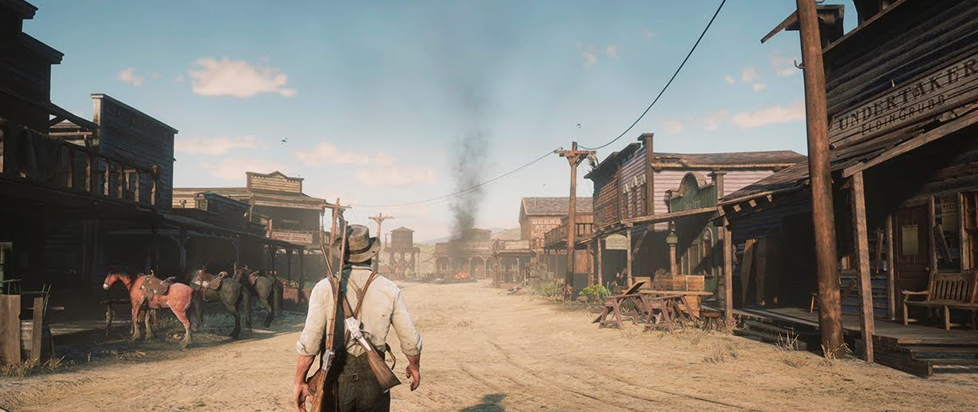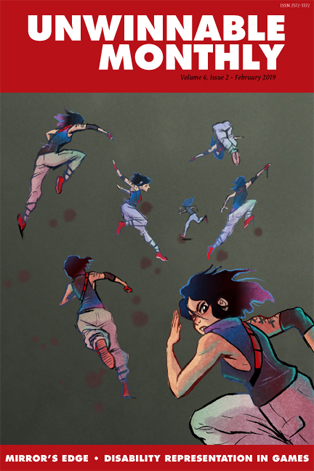
Armadillo Burning
 This column is a reprint from Unwinnable Monthly #112. If you like what you see, grab the magazine for less than ten dollars, or subscribe and get all future magazines for half price.
This column is a reprint from Unwinnable Monthly #112. If you like what you see, grab the magazine for less than ten dollars, or subscribe and get all future magazines for half price.
———
Corey Milne stands at the intersection of gaming and world history to see what he can see.
———
At the beginning of Red Dead Redemption 2, your band of outlaws are fleeing. They’re being pursued through snowy mountain passes and a number of them already dead or captured as you take your first wearisome steps as Arthur Morgan. As the game goes on, the gang is compelled to flee ever further to the east, as plans go awry and the law inevitably makes its presence felt. The West becomes a distant memory.
The narrative never really takes you back the way you came. The closest you get is a glimpse of Blackwater, the burgeoning city where the job that got you into all of this trouble went wrong. Your hide is wanted dead or alive in these parts, so you withdraw with your leader’s promise that you’ll come back one day. That you’ll retrieve your lost cash and disappear into the frontier.
It’s only when the game ends and events have reached their inevitable conclusion that you’re free to come and go as you please. A curious player might turn west, seeing part of their map still unexplored even after many hours of play. Finally, we can return to the wild lands and there’s a small town we used to know just over the next bluff.
The first thing I noticed as I rode into Armadillo late one night was definitely the fires. Several pyres burned openly on the main street. At the other end of the town, some bandits gunned down the sheriff. Windows are boarded up and some buildings have started to collapse. From the moment you step foot in town it’s clear that this isn’t the Armadillo that you remember from the original Red Dead Redemption. This town is sick and a shadow of its former self.
Nostalgia runs deep through Red Dead’s narrative. Dutch’s gang are always telling stories about how they belong back out west and how stifling they find “all this civilization.” Like the original game, it’s focused on a group who find themselves displaced in a new world, where their once held freedoms are being constricted by encroaching law and industry. They impotently strike back against these new structures, not realizing that every blow is rebounding and weakening their own foundation. The gang refuses to accept they’re the masters of their own demise, always on the lookout for that one big job that’ll send them home.
[pullquote]This town is sick and a shadow of its former self.[/pullquote]
This warped nostalgia stays with the game even when the story wraps up, with Armadillo as the centerpiece. A return to a key location from a previous game would often be cause for celebration in other titles. Not here. Armadillo is a ghost town before its time. On every wall posters hang informing you that cholera is ravaging the place. No trains run by its station, which is packed full with the sick, propped up against the walls and lying on the benches. The streets are no different. Mangy dogs with bloody patches where their fur used to be, wander among the walking dead. Corpses are left where they fall. A mass grave is being dug by the church. Everyone tells you to get out of town.
I found a Youtuber entering Armadillo for their first time, in the course of my peripheral research for this piece. At one point they looked at the camera, passed the town’s residents puking up their guts against the saloon and said how this just made them want Rockstar to remake Red Dead Redemption. The escapism that has the Van der Linde gang under its spell can be found in us, the players. Are we not looking to recapture those early days of Red Dead’s history, looking to the west? When younger versions of ourselves went on an adventure with a cowboy called John Marston. I can’t think of anything more antithetical to the Armadillo being presented than remaking the older game. There’s a point being made all too clearly in the darkened doorways and diseased wails of the dying townspeople.
Elsewhere other parts of the western map have been remade for players to wander around. I came across the old mine which in the old game saw John Marston shoot his way through some prospectors, while pushing a mine cart full of dynamite. There’s nothing to do here this time around. It’s an immaculately rendered, empty set. A home only to ghosts. Arthur, John, nor the rest of us are ever really going back. Those free-wheeling days in the Wild West will have to stay in the past because no matter how much we chase them, it’ll never be the same again.
———
Corey Milne is an Irish freelance writer who likes to poke at that strange intersection where games meet history. A roundup of his writing can be found at coreymilne.com. You can join his Rad-Lands motorcycle bandit gang on Twitter @Corey_Milne.




